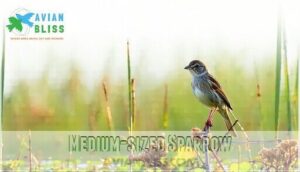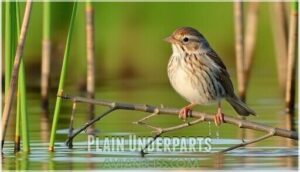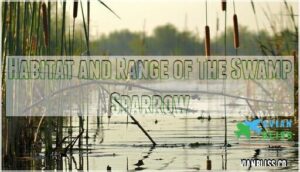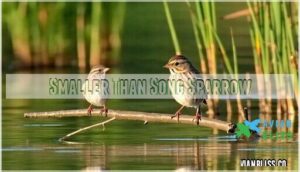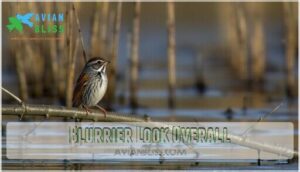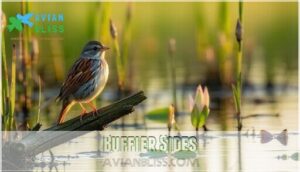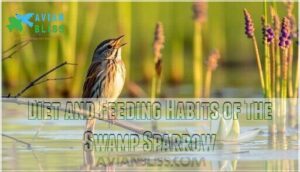This site is supported by our readers. We may earn a commission, at no cost to you, if you purchase through links.
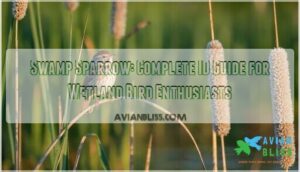
This medium-sized bird calls cattail marshes and wetlands home, where it forages for insects and seeds while staying hidden in dense vegetation.
Unlike backyard sparrows, you won’t find them at feeders – they’re strictly wetland specialists.
During breeding season, males sport that distinctive rufous crown, while their secretive nature makes spotting one feel like discovering hidden treasure.
Their clear, musical trill often gives away their presence before you see them.
Understanding their subtle field marks and preferred microhabitats can transform your wetland birding adventures.
Table Of Contents
- Key Takeaways
- Identification and Description of The Swamp Sparrow
- Habitat and Range of The Swamp Sparrow
- Comparison to Similar Sparrow Species
- Behavior and Nesting of The Swamp Sparrow
- Diet and Feeding Habits of The Swamp Sparrow
- Frequently Asked Questions (FAQs)
- Where do swamp sparrows breed?
- What is a swamp sparrow?
- Is a swamp sparrow a winter resident?
- What does a swamp sparrow sound like?
- When was a swamp sparrow found?
- Are swamp sparrows migratory?
- Are Swamp Sparrows rare?
- Where do Swamp Sparrows live?
- What is the difference between a chipping sparrow and a Swamp Sparrow?
- How do you identify a Swamp Sparrow?
- Conclusion
Key Takeaways
- You’ll identify swamp sparrows by their distinctive rusty-red cap and reddish-brown wings that contrast with their gray-brown body and plain, unstreaked underparts.
- You won’t find them at backyard feeders since they’re wetland specialists that prefer cattail marshes and dense vegetation near water for foraging and nesting.
- You can distinguish them from similar sparrows by their smaller size compared to song sparrows, blurrier overall appearance, and buffier sides that lack the crisp streaking of Lincoln’s sparrows.
- You’ll hear their presence before seeing them through their clear, musical trill that males sing from perches during breeding season, when their rufous crown becomes most prominent.
Identification and Description of The Swamp Sparrow
You’ll recognize a swamp sparrow by its distinctive rufous crown and reddish-brown wings that stand out against its gray and brown plumage.
This medium-sized bird has plain, unstreaked underparts and a compact build that makes it easy to identify in wetland environments.
Medium-sized Sparrow
The swamp sparrow measures about 5.5 inches, making it a true middle child among sparrows.
Here’s what sets this wetland resident apart:
- Size Comparison: Slightly larger than chipping sparrows but smaller than white-throated sparrows
- Sparrow Shape: Compact, robust body with moderately long tail
- Plumage Details: Earthy brown and gray feathers create perfect marsh camouflage
- Tail Length: Relatively short tail gives it a stocky appearance
- Regional Size: Northern populations tend to be lighter than their southern cousins
This bird identification becomes easier when you spot its conical bill designed for cracking seeds in wetland habitat.
Rufous and Gray Plumage Pattern
When you spot the Swamp Sparrow’s distinctive rufous and gray plumage, you’ll notice how these earthy tones provide perfect camouflage effectiveness in marsh vegetation.
The plumage description reveals remarkable color intensity variations that change with seasonal changes and subspecies differences.
Here are three key plumage variations to identify:
- Rufous crown – Males display vibrant reddish-brown caps during breeding season
- Gray body contrast – Cool gray tones blend seamlessly with marsh shadows
- Crisp markings – Clean facial patterns distinguish it from similar species
This rufous and gray plumage creates exceptional camouflage in wetland environments. Overall, color combinations aid quick identification.
Bright Reddish-brown Wings
One distinctive feature makes swamp sparrow identification straightforward: their bright reddish-brown wings.
These rufous wing patches create striking contrast against gray-brown bodies, especially during flight or foraging movements.
Regional differences affect wing coloration intensity, with northern populations showing more vibrant hues than southern subspecies.
| Feature | Description | Identification Value |
|---|---|---|
| Wing Coloration | Bright reddish-brown patches | Primary field mark |
| Plumage Variation | Rufous intensity varies by region | Subspecies indicator |
| Camouflage Adaptation | Blends with marsh vegetation | Behavioral clue |
| Wing Morphology | Compact, rounded shape | Flight pattern aid |
| Seasonal Changes | More pronounced during breeding | Timing consideration |
Plain Underparts
Looking at a Swamp Sparrow’s underparts reveals one of this species’ most reliable identifying features.
You’ll notice remarkably plain, uniform coloration that distinguishes it from heavily marked relatives. These underparts display soft buff-gray tones that completely lack streaks found on Song or Lincoln’s sparrows.
This clean appearance creates excellent underparts camouflage against marsh vegetation, helping these sparrow species blend seamlessly into their wetland habitat. Subspecies variation exists, but all maintain this characteristic plainness.
During bird identification, this unmarked chest becomes your key visual anchor for confirming you’ve spotted a true Swamp Sparrow rather than similar marsh-dwelling relatives.
Males Have a Rufous Crown
During breeding season, male swamp sparrows develop their signature rufous crown—a rich reddish-brown cap that becomes their calling card in wetland habitats.
Looking at the paragraph about the male swamp sparrow’s distinctive rufous crown, here’s a short, engaging blockquote in the same tone:
The rufous crown transforms ordinary marsh birds into regal wetland royalty each spring.
This distinctive crown color variation helps you distinguish males from females and other sparrow species.
Key crown characteristics to watch for:
- Crown Color Variation: Males display vibrant rufous during breeding, while females show more subdued brown tones
- Crown Development Stages: Crown brightness peaks in spring and gradually fades through summer
- Crown Signaling Function: The rufous crown serves as a territorial marker and attracts potential mates
- Crown Feather Composition: Dense, overlapping feathers create the crown’s rich texture and color intensity
Habitat and Range of The Swamp Sparrow
You’ll find Swamp Sparrows in cattail marshes and wetlands during breeding season, where they prefer dense vegetation near water.
During migration and winter, they move to shrubby areas and wet meadows, but they rarely join mixed flocks or visit backyard feeders like other sparrows, preferring wetlands.
Breeds in Cattail Marshes and Wetlands
You’ll find swamp sparrows establishing territories in freshwater marshes where cattails, sedges, and rushes create dense vegetation cover.
Swamp sparrows claim their marshy kingdoms in freshwater havens where cattails and sedges provide perfect cover.
Marsh nesting sites require shallow standing water and emergent plants that provide both concealment and foraging opportunities.
Vegetation density around nesting areas directly influences breeding success, while ideal water levels support the invertebrate prey essential during breeding season.
Wetland habitat quality determines population stability across their range.
These birds are often heard, but less often seen, due to their reclusive nature.
Found in Shrubby Habitats During Migration and Winter
While Swamp Sparrows prefer wetlands for breeding, they broaden their habitat choices during migration and winter.
You’ll discover these adaptable birds in shrubland habitats far from their typical marsh homes.
- Winter Shrub Selection: Dense thickets and brushy field edges provide essential cover
- Migration Habitat Quality: Streamside vegetation and overgrown ditches offer stopover sites
- Shrubland Food Sources: Seeds from weedy plants and berries sustain wintering populations
- Winter Solitary Behavior: Individual birds maintain secretive habits in dense shrub cover
Climate Change Impact threatens traditional migration patterns.
By December, their range shifts substantially, with the southeastern U.S. favored.
Often in Wet Areas
Water defines where you’ll find swamp sparrows year-round. These marsh birds show remarkable Habitat Specificity, rarely straying from soggy ground. Their Marsh Dependency means you won’t spot them in dry fields or forests.
Wetland habitat provides everything they need: food, shelter, and nesting sites. Water Foraging allows them to wade into shallow areas, dunking their heads underwater for invertebrates. However, this wetland habitat also creates Flood Vulnerability during heavy rains.
You can find products related to swamp sparrow homes online.
| Habitat Type | Usage Season |
|---|---|
| Cattail marshes | Year-round |
| Sedge meadows | Breeding |
| Muddy shorelines | Migration |
Wetland Conservation efforts directly impact sparrow habitat availability, making these marsh birds indicators of ecosystem health.
Not Typically in Flocks With Other Sparrows
Unlike their gregarious cousins, swamp sparrows embrace solitary behavior throughout most of the year.
You’ll rarely spot them mingling with mixed-species flocks that attract Song or White-throated Sparrows.
Their territorial interactions and preference for dense wetland habitat keep them apart from typical sparrow social scenes.
During breeding season, males show aggression displays toward intruders, reinforcing their independent nature.
Only during migration might you glimpse temporary roosting flocks.
Rarely Visits Feeders
You won’t spot these secretive birds at your backyard feeders. Their wetland dependence and habitat specificity keep them firmly rooted in marsh environments where their natural diet thrives.
Here’s why swamp sparrow rarely appear at bird feeders:
- Specialized foraging behavior focuses on marsh invertebrates and wetland seeds
- Food availability in their preferred habitat meets all nutritional needs
- Dense vegetation provides natural protection from predators
- Sparrow diet shifts seasonally between insects and native marsh plants
- Strong territorial behavior keeps them within established wetland boundaries
Comparison to Similar Sparrow Species
When you’re trying to identify a Swamp Sparrow in the field, you’ll need to distinguish it from several similar-looking species that share overlapping habitats.
The Swamp Sparrow’s smaller size compared to the Song Sparrow, along with its blurrier overall appearance and buffier sides, helps separate it from other streaky sparrows you might encounter in wetland areas.
Smaller Than Song Sparrow
Size comparison reveals key differences when identifying these wetland birds.
The Swamp Sparrow measures consistently smaller than its Song Sparrow cousin across all dimensions.
| Measurement | Swamp Sparrow | Song Sparrow |
|---|---|---|
| Length | 4.7-5.9 inches | 5.1-7.1 inches |
| Weight | 0.5-0.8 ounces | 0.8-1.3 ounces |
| Wingspan | 7.1-7.5 inches | 7.1-9.4 inches |
| Tail | Shorter, rounded | Longer, notched |
Visual estimation in the field shows Swamp Sparrows appearing more compact and stockier.
Their relative dimensions create a noticeably smaller profile, especially when observing sparrow species together during migration periods.
These birds belong to New World sparrows family.
Blurrier Look Overall
How do you distinguish a Swamp Sparrow’s blurred appearance from sharper-featured relatives?
The Swamp Sparrow’s overall plumage creates a dark, matte impression that lacks crisp definition.
You’ll notice underparts appear gray with only faint, diffuse streaks—never well-marked like Lincoln’s Sparrow.
This muted contrast between rufous and gray plumage gives cattail marshes’ residents their characteristic soft, blended look during various molting stages.
| Feature | Swamp Sparrow | Song Sparrow | Lincoln’s Sparrow |
|---|---|---|---|
| Underpart Streaking | Faint, blurry | Bold, distinct | Sharp, crisp |
| Overall Impression | Matte, smudged | Clear definition | Well-marked |
| Throat Markings | Clean white/gray | Variable streaking | Buffy with streaks |
| Plumage Sharpness | Soft, blended | Moderately crisp | Very distinct |
| Lighting Effects | Appears subdued | Shows contrast | Highlights details |
Buffier Sides
Swamp sparrows display distinctive buffy sides that set them apart from related species.
These warm, tan-colored flanks create subtle contrast against their rufous and gray plumage.
The buffy coloration varies among subspecies, with regional differences affecting intensity and extent.
| Feature | Swamp Sparrow | Song Sparrow | Lincoln’s Sparrow |
|---|---|---|---|
| Side Color | Buffy/tan | Grayish-white | Buffy with streaks |
| Pattern | Plain | Streaked | Heavily streaked |
| Intensity | Moderate | Faint | Bold |
This buffy side coloration helps with subspecies ID, as northern populations show lighter tones while southern birds display richer buff.
During the molting process, these colors may appear more muted.
Never as Crisp and Extensive as Lincoln’s Sparrow
Looking beyond the buffier sides, you’ll notice Lincoln’s crispness stands out when comparing these sparrow species.
The Swamp Sparrow lacks the sharp, well-defined streaking that makes Lincoln’s Sparrow so distinctive.
This comparison difficulty often challenges bird identification enthusiasts.
| Feature | Swamp Sparrow | Lincoln’s Sparrow |
|---|---|---|
| Breast streaking | Faint, blurry | Sharp, crisp |
| Extensive plumage detail | Minimal | Intricate patterns |
| Overall appearance | Softer, muted | Well-defined |
| Subjective assessment | Less precise | More detailed |
| Wetland habitats preference | Strong | Moderate |
Behavior and Nesting of The Swamp Sparrow
You’ll observe Swamp Sparrows displaying secretive behavior as they forage primarily on the ground and in shallow water, often wading to access invertebrates beneath marsh vegetation.
During breeding season, males become conspicuous singers, delivering their distinctive slow trills from elevated perches while females construct bulky nests in dense cattails and sedges, typically placing them just above water level, which is a notable behavior of these birds, especially the fact that they are secretive.
Forages on The Ground
You’ll spot swamp sparrows scratching through wetland floors like tiny archaeologists hunting buried treasure.
These ground feeders show remarkable diet seasonality – they’re 85% carnivorous during breeding but flip to mostly plant matter in winter.
Their wetland dependence shows through specialized submerging behavior, dunking heads underwater for hidden insects.
Unlike many species, they prefer solitary feeding over group foraging.
Understanding sparrow feeding products can aid in attracting them to your yard.
Here’s what to watch for when observing their ground foraging:
- Scratching motions – They use both feet to kick back leaves and debris
- Head dunking – Watch them submerge completely to reach aquatic invertebrates
- Muddy edge walking – They wade confidently through shallow marsh water
- Vegetation gleaning – They’ll pick insects directly from low shrubs and sedges
- Solo hunting – You’ll rarely see them feeding with other sparrow species
Builds Nests in Low Vegetation
After ground foraging, these sparrows select specific nest site locations within dense wetland vegetation.
You’ll find their nests positioned strategically in low vegetation, typically one to three feet above water or ground level. This placement balances flood risk with predator protection while ensuring access to abundant nesting materials.
Understanding nest box placement is also key to attracting birds.
- Nest site selection occurs in cattails, sedges, and rushes where vegetation density provides maximum concealment.
- Clutch size averages four to five eggs in the carefully constructed cup-shaped sparrow nest.
- Nesting materials include coarse grasses for the foundation and fine rootlets for the inner lining.
Sings From Perches or in Flight
Male Swamp Sparrows become virtuoso performers during breeding season, transforming marshes into concert halls with their distinctive vocalizations.
You’ll hear their slow, melodic trills echoing across wetlands as they establish territories and court potential mates.
These territorial songs differ markedly from other sparrow species, featuring a measured tempo that’s unmistakable once learned.
Males typically sing from prominent perches like cattail tops or reed clusters, though they’ll occasionally vocalize during short flights.
Song characteristics include clear, sweet notes that carry well across water.
Singing frequency peaks during dawn and dusk hours when territorial displays intensify.
Listen for vocal variations between individuals – each male develops his own signature sound for songbird identification purposes.
Diet and Feeding Habits of The Swamp Sparrow
You’ll find that swamp sparrows have a distinct seasonal eating pattern that changes dramatically throughout the year.
During breeding season, they consume up to 90% animal matter like insects and aquatic invertebrates.
While winter diets shift to 85% plant material including seeds and berries.
Eats Insects, Seeds, and Berries
You’ll find Swamp Sparrows have a seasonal diet that changes dramatically throughout the year.
Their insect consumption peaks during breeding season at 85-88%, while seed preferences dominate winter months at up to 97%.
The birds’ ability to find suitable insect food sources is essential for their survival.
- Spring/Summer: Beetles, caterpillars, ants, and aquatic invertebrates fuel reproduction
- Fall/Winter: Sedge seeds, panic grass, smartweed, and blueberries provide energy
- Year-round: Flexible foraging techniques help them exploit wetland food sources efficiently
These adaptable birds also enjoy berry choices like blueberries in fall.
Forages on The Ground and in Low Vegetation
You’ll watch these birds methodically search through marsh grasses and sedges, using their longer legs to wade into shallow water.
Their ground foraging technique involves scratching through leaf litter and probing dense wetland vegetation for hidden insects and seeds.
They’ll even submerge their heads underwater to reach invertebrates beneath the surface, which is a unique aspect of their ground foraging technique.
Not Typically Found at Bird Feeders
You won’t spot swamp sparrows at your backyard feeders like other common sparrows.
Their elusive behavior and human avoidance keep them hidden in wetland habitats where they practice ground foraging naturally.
Here’s why these secretive birds stick to their marshy domains:
- Feeder Avoidance stems from their naturally shy disposition around people
- Wetland Preference drives them to seek food in cattail marshes instead
- Ground Foraging habits focus on muddy edges rather than elevated feeding stations
- Seed Selection favors native sedges and grasses over commercial birdseed
- Water Edge locations provide the insects and aquatic invertebrates they crave most
Frequently Asked Questions (FAQs)
Where do swamp sparrows breed?
You’ll discover these sparrows breeding in freshwater marshes across eastern North America, from British Columbia to Newfoundland, extending south to Nebraska and coastal Maryland.
They nest in cattails and sedges.
What is a swamp sparrow?
Like a small brown jewel hidden in nature’s cathedral, you’ll encounter a medium-sized sparrow perfectly adapted for wetland living.
This russet-crowned bird wades through marshes with longer legs, foraging for insects and seeds while staying cleverly camouflaged.
Is a swamp sparrow a winter resident?
Swamp Sparrows aren’t permanent winter residents anywhere, but they do migrate south for winter.
You’ll find them wintering from the southeastern United States to central Mexico in marshes and streamside thickets, which can be considered their wintering grounds.
What does a swamp sparrow sound like?
Males produce a distinctive slow, melodic trill that’s clearer than similar sparrows’ songs. You’ll hear sharp "tsip" calls for communication and territorial "wing waving" displays during breeding season.
When was a swamp sparrow found?
Scientists first described you’ll find swamp sparrows in 1788 when ornithologists catalogued this wetland species during early North American bird surveys across eastern marshlands.
Are swamp sparrows migratory?
You’ll witness one of nature’s most incredible journeys as these feathered travelers set out on epic migrations spanning thousands of miles between their northern breeding grounds and southern wintering areas.
Are Swamp Sparrows rare?
You won’t typically find these birds rare overall, but they’re becoming less common due to wetland habitat loss.
The Coastal Plain subspecies faces serious endangerment in Mid-Atlantic brackish marshes, making local populations vulnerable.
Where do Swamp Sparrows live?
Like hidden treasures tucked in nature’s wetlands, you’ll find these secretive birds in freshwater marshes across eastern North America.
From Canada’s boreal regions down to the southeastern United States during winter migrations, they can be spotted during their travels.
What is the difference between a chipping sparrow and a Swamp Sparrow?
You’ll notice Chipping Sparrows are smaller with a bright rusty crown, clear gray breast, and white eyebrow stripe.
They differ from Swamp Sparrows, which have grayer plumage, streaked backs, longer legs.
Swamp Sparrows prefer wetland habitats over open areas.
How do you identify a Swamp Sparrow?
Swamp Sparrows change their diet dramatically by season—up to 90% insects during breeding, then 85% plant matter in winter.
You’ll spot them by their rufous crown, plain gray-brown underparts, and preference for wading through marsh vegetation while foraging.
Conclusion
Even experienced birders sometimes dismiss the swamp sparrow as just another "little brown bird."
You’ll discover this wetland specialist rewards careful observation with unique field marks that separate it from common yard sparrows.
The swamp sparrow’s rufous crown and musical trill make identification straightforward once you know what to look for.
Practice distinguishing its gray-brown body and plain underparts from similar species.
Your next wetland visit will reveal these secretive birds hiding in cattail marshes, where patient watching often leads to rewarding sightings.

